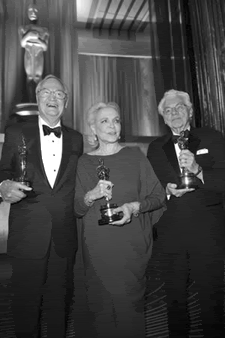
Announced Monday March 1st are the nominees for the 28th Annual Genie Awards. For those a tad confused about the Genie's identity, here's a simple breakdown:
Oscar = American
BAFTA = British
Genie = Canadian, like Oscar and BAFTA, but not
Juno = Canadian MUSIC, not film
Gemini = Canadian TV, not film
Genie = CANADIAN FILM, not like Oscar / American film / bald statue / heavy paperweight
All clear?
Excellent.
The awards will be handed out in Toronto, April 12th, with Gordon Pinsent hosting the televised ceremonies, although what network and time isn't clear at the Genie's
official website, since the stated airdate (and previous year's winners) is frozen for the year 2008.
Ahem.
A pleasant surprise is how many of the films, both in English and French, are available on DVD and Blu-ray, which has to be a positive signal that, while Canadian films still have to fight for theatrical screen time, there are more options out there for home video (or everyone just smartly planned ahead in their marketing strategies). All of the films are out, and several were released prior to March 1st, which makes it easy for anyone to sample some of the best in Canadian film before the awards ceremonies in April.
So - Here are the nominees in each category, with titles currently on video hyperlinked to related reviews / Amazon.ca links:
.BEST MOTION PICTURE / MEILLEUR FILM
3 SAISONS – Maude Bouchard, Jim Donovan, Sandy Martinez, Bruno Rosato
BEFORE TOMORROW – Stéphane Rituit
FIFTY DEAD MEN WALKING – Shawn Williamson, Stephen Hegyes, Peter La Terriere, Kari Skogland
NURSE.FIGHTER.BOY – Ingrid Veninger
POLYTECHNIQUE – Maxime Rémillard, Don Carmody
..ACHIEVEMENT IN DIRECTION / MEILLEURE RÉALISATION
MARIE-HÉLÈNE COUSINEAU, MADELINE PIUJUQ IVALU – Before Tomorrow
KARI SKOGLAND – Fifty Dead Men Walking
CHARLES OFFICER – NURSE.FIGHTER.BOY
DENIS VILLENEUVE – Polytechnique
BRUCE MCDONALD –
Pontypool..ORIGINAL SCREENPLAY / MEILLEUR SCÉNARIO
ATOM EGOYAN –
AdorationÉMILE GAUDREAULT, IAN LAUZON –
De père en flic / Father and GunsCHARLES OFFICER, INGRID VENINGER – NURSE.FIGHTER.BOY
JACQUES DAVIDTS – Polytechnique
DAVID BEZMOZGIS –
Victoria Day..ADAPTED SCREENPLAY / MEILLEURE ADAPTATION
MARIE-HÉLÈNE COUSINEAU, SUSAN AVINGAQ, MADELINE PIUJUQ IVALU – Before Tomorrow
KARI SKOGLAND – Fifty Dead Men Walking
TONY BURGESS – Pontypool
..PERFORMANCE BY AN ACTOR IN A LEADING ROLE / INTERPRÉTATION MASCULINE DANS UN PREMIER RÔLE
JEAN-CARL BOUCHER – 1981
PAUL DYLAN IVALU – Before Tomorrow
JOSHUA JACKSON –
One Week
CLARK JOHNSON – NURSE.FIGHTER.BOY
STEPHEN MCHATTIE – Pontypool
..PERFORMANCE BY AN ACTRESS IN A LEADING ROLE / INTERPRÉTATION FÉMININE DANS UN PREMIER RÔLE
MADELINE PIUJUQ IVALU – Before Tomorrow
KAREN LEBLANC – NURSE.FIGHTER.BOY
CARINNE LEDUC – 3 Saisons
GABRIELLE ROSE – Mothers&Daughters
KARINE VANASSE – Polytechnique
..PERFORMANCE BY AN ACTOR IN A SUPPORTING ROLE / INTERPRÉTATION MASCULINE DANS UN RÔLE DE SOUTIEN
PATRICK DROLET – De père en flic / Father and Guns
JOHN DUNSWORTH –
Trailer Park Boys: Countdown to Liquor Day
MAXIM GAUDETTE – Polytechnique
RÉMY GIRARD – De père en flic / Father and Guns
SCOTT SPEEDMAN – Adoration
..PERFORMANCE BY AN ACTRESS IN A SUPPORTING ROLE / INTERPRÉTATION FÉMININE DANS UN RÔLE DE SOUTIEN
LIANE BALABAN – One Week
MARIE BRASSARD –
Les grandes chaleurs / Heat Wave
MARTHA BURNS –
Love & SavageryISABEL RICHER –
BabineSONIA VACHON – 5150, rue des Ormes / 5150 Elm’s Way
..ACHIEVEMENT IN ART DIRECTION, PRODUCTION DESIGN / MEILLEURE DIRECTION ARTISTIQUE
DIANA ABBATANGELO – NURSE.FIGHTER.BOY
SUSAN AVINGAQ – Before Tomorrow
JEAN BABIN – Grande ourse: La clé des possibles / The Master Key
EVE STEWART – Fifty Dead Men Walking
PATRICE VERMETTE – 1981
..ACHIEVEMENT IN CINEMATOGRAPHY / MEILLEURES IMAGES
STEVE COSENS – NURSE.FIGHTER.BOY
JONATHAN FREEMAN – Fifty Dead Men Walking
PIERRE GILL – Polytechnique
RONALD PLANTE – Grande ourse: La clé des possibles / The Master Key
ALLEN SMITH –
Les doigts croches / Sticky Fingers..ACHIEVEMENT IN COSTUME DESIGN / MEILLEURS COSTUMES
ATUAT AKITTIRQ – Before Tomorrow
CARMEN ALIE – Grande ourse: La clé des
possibles / The Master Key
SARAH ARMSTRONG – NURSE.FIGHTER.BOY
BRENDA BROER –
Cairo TimeANNE-KARINE GAUTHIER – 1981
..ACHIEVEMENT IN EDITING / MEILLEUR MONTAGE
ALAIN BARIL – 5150, rue des Ormes / 5150 Elm’s Way
RICHARD COMEAU – Polytechnique
FRANÇOIS NORMANDIN, JIM DONOVAN – 3 Saisons
MICHEL GROU – Grande ourse: La clé des possibles / The Master Key
JIM MUNRO – Fifty Dead Men Walking
..ACHIEVEMENT IN MAKE-UP / MEILLEURS MAQUILLAGES
DJINA CARON, MARTIN RIVEST – Polytechnique
DJINA CARON – Grande ourse: La clé des possibles / The Master Key
DIANE SIMARD, RÉJEAN GODERRE – Love & Savagery
MICHELINE TRÉPANIER, LINDA GORDON – 1981
ROBBI O’QUINN, LEANNE MORRISON-FREED –
You Might As Well Live..ACHIEVEMENT IN MUSIC – ORIGINAL SCORE / MEILLEURE MUSIQUE ORIGINALE
BENOÎT CHAREST – Polytechnique
BERTRAND CHÉNIER – Love & Savagery
CHRISTIAN CLERMONT – 5150, rue des Ormes / 5150 Elm’s Way
NORMAND CORBEIL – Grande ourse: La clé des possibles / The Master Key
BEN MINK – Fifty Dead Men Walking
..ACHIEVEMENT IN MUSIC – ORIGINAL SONG / MEILLEURE CHANSON ORIGINALE
SUSAN AVINGAQ – Before Tomorrow – "Pamani"
JOHN WELSMAN, CHERIE CAMP – NURSE.FIGHTER.BOY – "Oh Love"
SARI DAJANI, IOHANN MARTIN, RUDY TOUSSAINT, JOHN VON AICHLINGER –
Les grandes chaleurs / Heat Wave – "Bon Swa"
..ACHIEVEMENT IN OVERALL SOUND / MEILLEUR SON D’ENSEMBLE
MARIO AUCLAIR, DANIEL BISSON, LUC BOUDRIAS, JEAN-CHARLES DESJARDINS – Grande ourse: La clé des possibles / The Master Key
STÉPHANE BERGERON, PIERRE BLAIN, JO CARON, BENOÎT LEDUC – Polytechnique
CLAUDE HAZANAVICIUS, DANIEL BISSON, JEAN-CHARLES DESJARDINS, BERNARD GARIÉPY STROBL – Love & Savagery
RICHARD LAVOIE, ARNAUD DERIMAY, JEAN-CHARLES DESJARDINS, BERNARD GARIÉPY STROBL – Before Tomorrow
SIMON GOULET, BERNARD GARIÉPY STROBL – 5150, rue des Ormes / 5150 Elm’s Way
..ACHIEVEMENT IN SOUND EDITING / MEILLEUR MONTAGE SONORE
PIERRE-JULES AUDET, MICHELLE CLOUTIER, JACQUES PLANTE, JEAN-FRANÇOIS SAUVÉ – Grandeourse: La clé des possibles / The Master Key
MATHIEU BEAUDIN, JACQUES PLANTE – 5150, rue des Ormes / 5150 Elm’s Way
CLAUDE BEAUGRAND, GUY FRANCOEUR, CAROLE GAGNON, CHRISTIAN RIVEST – Polytechnique
GARRETT KERR, FRED BRENNAN, PAUL GERMANN, STEVE HAMMOND, MISHANN LAU – NURSE.FIGHTER.BOY
OLIVIER CALVERT, NATALIE FLEURANT, FRANCINE POIRIER, LISE WEDLOCK –
Babine..BEST FEATURE LENGTH DOCUMENTARY / MEILLEUR LONG MÉTRAGE DOCUMENTAIRE
A HARD NAME – Kristina McLaughlin, Michael McMahon, Alan Zweig
LES DAMES EN BLEU / LADIES IN BLUE – Claude Demers
INSIDE HANA’S SUITCASE – Larry Weinstein, Rudolf Biermann, Jessica Daniel
PROM NIGHT IN MISSISSIPPI – Patricia Aquino, Paul Saltzman
RIP: A REMIX MANIFESTO – Mila Aung-Thwin, Kat Baulu, Brett Gaylor, Germaine Ying-Gee Wong
..BEST SHORT DOCUMENTARY / MEILLEUR COURT MÉTRAGE DOCUMENTAIRE
THE DELIAN MODE – Kara Blake, Marie-Josée Saint-Pierre
PASSAGES – Marie-Josée Saint-Pierre
PETROPOLIS: AERIAL PERSPECTIVES ON THE ALBERTA TAR SANDS – Peter Mettler, Sandy Hunter, Laura Severinac ---
DVD available March 30..BEST LIVE ACTION SHORT DRAMA / MEILLEUR COURT MÉTRAGE DRAMATIQUE
DANSE MACABRE – Pedro Pires, Catherine Chagnon
GILLES – Constant Mentzas
PRINCESS MARGARET BLVD. – Dan Montgomery, Kazik Radwanski
TERRE DES HOMMES / LAND OF MEN – Ky Nam Le Duc
LA VIE COMMENCE / LIFE BEGINS – Élaine Hébert, Émile Proulx-Cloutier
..BEST ANIMATED SHORT / MEILLEUR COURT MÉTRAGE D’ANIMATION
RUNAWAY / TRAIN EN FOLIE – Derek Mazur, Cordell Barker, Michael Scott
THE SPINE / L’ÉCHINE – Steven Hoban, Chris Landreth, Marcy Page
VIVE LA ROSE – Michael Fukushima, Bruce Alcock, Annette Clarke, Tina Ouellette
..GOLDEN REEL AWARD
De père en flic / Father and Guns - Denise Robert, Daniel Louis
..CLAUDE JUTRA AWARD
J'ai tué ma mère / I Killed My Mother - Xavier Dolan
..ACADEMY ACHIEVEMENT AWARD
Mel Hoppenheim
...--30--
 Just uploaded are a pair of reviews for two Christopher Young soundtracks: Love Happens (La-La Land Records) has the veteran composer and avid practitioner of musique concrete, avant garde and modern classical techniques writing a romantic drama score (and it works!), whereas Creation (U.K.: Silva Screen, U.S.: Lakeshore Records) is a character study that inspired Young to write one of his best scores in years – light, dreamy, and proof-positive Young is the King of Melancholia.
Just uploaded are a pair of reviews for two Christopher Young soundtracks: Love Happens (La-La Land Records) has the veteran composer and avid practitioner of musique concrete, avant garde and modern classical techniques writing a romantic drama score (and it works!), whereas Creation (U.K.: Silva Screen, U.S.: Lakeshore Records) is a character study that inspired Young to write one of his best scores in years – light, dreamy, and proof-positive Young is the King of Melancholia.
















